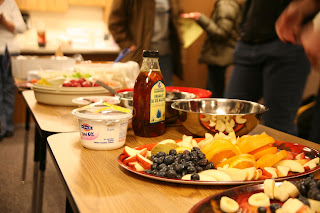We had a fabulous January R.S. Activity ! A special thanks to the committee for their hard work in putting it together. Also thanks to Candice Issacson, Julie Bree, and Chante Hammond for their willingness to share their knowledge and expertise with us. They shared great information and helpful tips and tricks in relation to home organization, healthy eating, and money management. We have included some photos, information, handouts and recipes from the evening. (Not every recipe was collected, so if you made something and your recipe isn't here, please send to Casey Roberts, and she will add it to the blog.)
RECIPES
Pumpkin Apple Streusel Muffins (Julie Bree)
(Modified to increase whole grains and decrease fat and sugar)
Muffins:
1 1/2 c. whole
wheat flour
1 c.
all-purpose flour
1 c. sugar
1 Tbsp.
pumpkin pie spice (or 1 1/2 tsp. cinnamon, 3/4 tsp. ginger, 3/4 tsp. allspice, 1/4 tsp.
nutmeg)
1 tsp.
baking soda
1/2 tsp. salt
2 eggs,
lightly beaten
1 c. canned
pumpkin
1/2 c.
applesauce
2 c. peeled,
cored, and chopped apples
Streusel:
2 Tbsp.
all-purpose flour
1/4 c. white
sugar
1/2 tsp.
cinnamon
4 tsp.
margarine or butter
- Preheat oven to 350⁰ F. Lightly grease or spray 18-24
muffin cups.
- In a large bowl, mix flours, sugar, spices, soda
and salt. In a separate bowl, combine eggs, pumpkin and applesauce. Combine and stir until just moistened.
Fold in apples. Spoon into greased muffin tins.
- To prepare streusel, stir together flour, sugar
and cinnamon in a small bowl. Cut in margarine until resembles small crumbs.
Sprinkle evenly over muffin batter.
- Bake for 18-22 minutes or until toothpick comes
out clean.
Healthy Ginger Cookies (Kim Broadhead)
1 1/2 cups shortening
2 cups sugar
2 1/2 eggs
1/2 cup molasses
1 1/2 TBSP vanilla
1 1/2 TBSP soda
5 1/2 cups flour
1 tsp salt
2 TBSP ginger
2 tsp cinnamon
Mix in order of ingredients, scoop and roll in sugar
Bake 9-10 minutes. Makes 5 dozen. Calories: 102 Total fat: 4 grams Carbs: 16 grams
Cucumber Yogurt Dip with Dill
1 cup low-fat plain yogurt
1 cucumber, chopped
1 TBSP fresh dill, chopped
garlic powder
1 TBSP olive oil
freshly ground black pepper
In a serving bowl place yogurt. Add cucumber, dill, garlic powder to taste, olive oil and freshly ground black pepper. Whisk to combine. Chill for up to four hours, and serve with vegetables like carrots, celery, broccoli, cauliflower, bell peppers and squash or with pita bread cut into triangles.
Granola (Casey Roberts)
1/2 cup butter
1/2 cup maple syrup
1/2 cup corn syrup
1/2 cup brown sugar
4 cup regular oats
2 cup coconut
2 cups nuts: 2/3 cup
slivered almonds, 2/3
cup chopped walnuts,
2/3 cup chopped
pecans
1 tbsp sesame seeds
1 cup wheat germ
2 cup raisins
1 or 2 cup dried
cranberries, peaches
or dates
Combine butter, maple syrup, corn syrup, brown sugar in a saucepan and bring to a boil. Add sugar mixture to the oats, coconut, nuts, seeds and wheat germ. Spread onto 2 cookie sheets. Bake at 300° for 30 minutes, stirring every 7-8 minutes. Add fruit to mixture and bake 20 more minutes until fruit expand. Remove from oven and cool, stirring every few minutes. (For the activity, I made this without the sesame seeds, wheat germ, raisins, and dried fruit)
ORGANIZATION
Organizing Tips Handout:
Rotating Cleaning Chore Cards Handout:
43 Cleaning Tips for Kids Handout:
HEALTHY EATING
MONEY MATTERS
Helpful tips and links for finances:
Some of the ideas for teaching
children include: Play
"show and tell" while you manage your own money. practice what you
preach and explain why you buy and don’t buy certain
things. Help
your child start a savings or investment account. Coincidentally
the government recommends
starting this around age 8. Give an allowance. If used as a
teaching tool and not a giveaway, an allowance can be one of the best ways to
teach kids, even as young as five or six, about money management.
Consider gifts that encourage saving. Examples include U.S. Savings Bonds and books that
reinforce financial responsibility.
Encourage
older children to get work experience. Summer or part-time jobs can teach young people good
business skills and how to be responsible. They also may enjoy earning and
saving money.
For more help or information for parents: The FDIC has a new
financial education program for youths between the ages of 12 and 20 that is
primarily for use by teachers but also can help parents explain the basics of
good money-management to their children. You can order a free CD of the FDIC's "Money
Smart for Young Adults" at www.fdic.gov/consumers/consumer/moneysmart/young.html.
Find
other resources on money management for youths from the Jump$tart Coalition® for
Personal Financial Literacy, which consists of more than 180 national partners,
including the FDIC (go to www.jumpstart.org), and the money
pages at www.kids.gov, a federal government Web site for children and
educators.
Budget links:







































